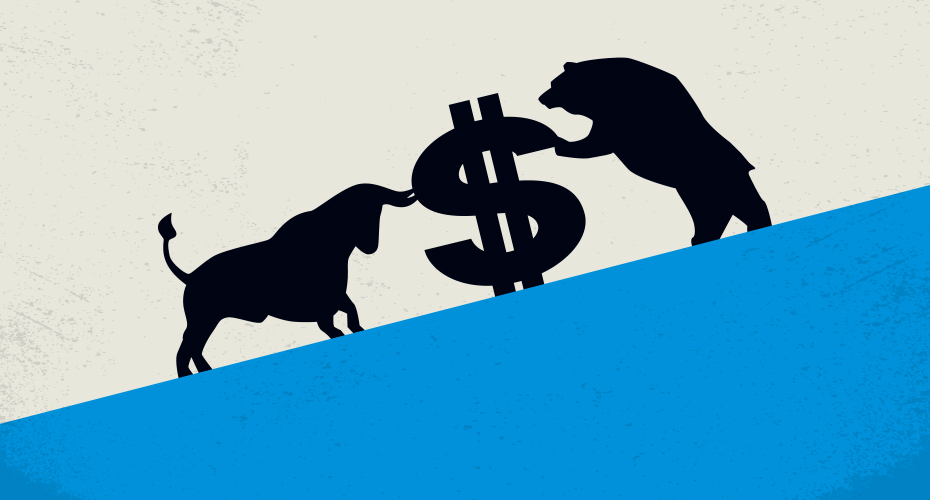Published June 7, 2024 • 5 Min Read
Summing up market conditions as “bearish” (falling prices) or “bullish” (rising prices) can be helpful shorthand, but investors should dig a little deeper to really understand what’s going on and what it means for them.
The first thing to know is that bear and bull markets are a natural part of long-term investing, and they come in all shapes and sizes. Financial markets go through cycles of expansion and contraction. In other words: change is always coming.
Bear Market vs. Bull Market: A Primer
| Bear Market | Bull Market | |
| Origins of the name | A bear market gets its name from the way a bear attacks its prey. Bears strike downwards. | A bull market gets its name from the way bulls move their horns confidently upward when they charge. |
| How you might see it used | Falling prices are considered “bearish.” | Surging prices and upbeat investor sentiment are referred to as “bullish”. |
| Defining the term | A market enters “bear” territory when it experiences persistent falling prices. It typically describes a condition in which securities prices fall 20 percent or more from recent highs amid other negative economic indicators such as sluggish growth. | A bull market occurs when things are looking up and prices continue to rise because there are more buyers than sellers. Generally, a bull market occurs when there is a rise of 20 percent or more in a broad market index over at least a two-month period. |
| Underlying causes | Bear markets can have various causes. A recession often accompanies decreased spending and investment, which can trigger a bear market. Wars, pandemics, economic bubbles, credit crunches and sudden supply shocks can also be triggers. | Positive economic data can trigger a bull market, such as GDP growth and strong corporate earnings. Global events such as the easing of a high-stakes conflict or rapid advances in a new market like artificial intelligence can also attract more investors and fuel a bull market. |
How Long Will a Given Market Last?
The duration of a bear or bull market can be long, short or somewhere in between. The longest bear market of the last 100 years was the Great Depression, spanning three years from 1929 to 1932. A much shorter bear market occurred in the early days of the COVID-19 pandemic, when worrying economic data triggered investor panic and a sharp sell-off in February 2020. It ultimately lasted only a month before investors were reassured by swift government action and stimulus measures.
On the bull market side, the longest run in recent times was the nearly 11 years of the Great Recovery (following the Great Recession) from March 2009 to February 2020. This was a time of global economic expansion and near-zero interest rates. A much shorter bull market occurred in 1987, when corporate earnings growth and tax cuts shot investor optimism high for several months before the “Black Monday” stock market crash on October 19, 1987.
Should I Try to Time the Market?
It’s notoriously difficult to time the market. Bullish or bearish conditions are determined by a confluence of complex forces. This includes investor sentiment, economic indicators, geopolitical events and interest rates. No two periods are going to play out exactly the same way. Even within a given economic period, there will be market rallies and market downturns that don’t meet the criteria to be called a bear or bull market.
Investors who understand the difference between bull and bear markets are less likely to panic when market conditions change, and more likely to take a long-term perspective and maintain a diverse portfolio. When in doubt, zoom out from the day’s economic conditions and remember that market changes are a normal part of the long-term investment cycle.
You can also consider seeking advice from an advisor if you want help refining your investment strategy to meet your objectives. Both bear and bull markets have the ability to influence your emotions and behaviour but having a financial plan in place can help keep your long-term goals in focus.
This article is intended as general information only and is not to be relied upon as constituting legal, financial or other professional advice. A professional advisor should be consulted regarding your specific situation. Information presented is believed to be factual and up-to-date but we do not guarantee its accuracy and it should not be regarded as a complete analysis of the subjects discussed. All expressions of opinion reflect the judgment of the authors as of the date of publication and are subject to change. No endorsement of any third parties or their advice, opinions, information, products or services is expressly given or implied by Royal Bank of Canada or any of its affiliates.
Investment advice is provided by Royal Mutual Funds Inc. (RMFI). RMFI, RBC Global Asset Management Inc., Royal Bank of Canada, Royal Trust Corporation of Canada and The Royal Trust Company are separate corporate entities which are affiliated. RMFI is licensed as a financial services firm in the province of Quebec.
This article is intended as general information only and is not to be relied upon as constituting legal, financial or other professional advice. A professional advisor should be consulted regarding your specific situation. Information presented is believed to be factual and up-to-date but we do not guarantee its accuracy and it should not be regarded as a complete analysis of the subjects discussed. All expressions of opinion reflect the judgment of the authors as of the date of publication and are subject to change. No endorsement of any third parties or their advice, opinions, information, products or services is expressly given or implied by Royal Bank of Canada or any of its affiliates.
Share This Article






